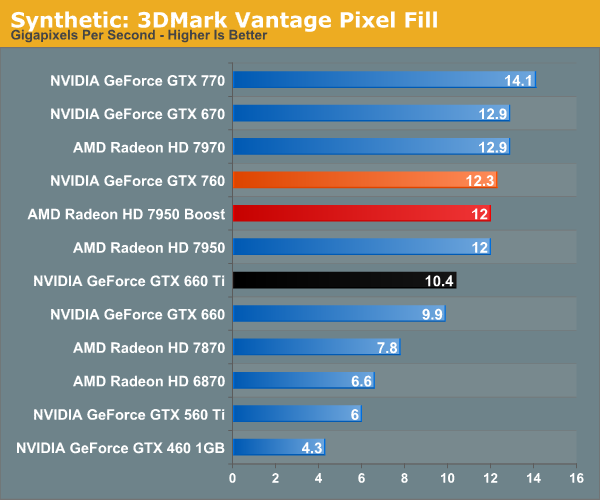NVIDIA GeForce GTX 760 Review: The New Enthusiast Kepler
by Ryan Smith on June 25, 2013 9:00 AM ESTSynthetics
As always we’ll also take a quick look at synthetic performance, though as GTX 760 is just another GK104 card, there shouldn't be any surprises here. These tests are mostly for comparing cards from within a manufacturer, as opposed to directly comparing AMD and NVIDIA cards. We’ll start with 3DMark Vantage’s Pixel Fill test.

The 3DMark Pixel Fill test confirms what we’ve seen in or earlier results, with the full 32 ROP/256-bit configuration of the GTX 760 giving the card a notable advantage in this ROP and memory bandwidth bound scenario. It also validates why the GTX 670 and GTX 760 are so close in these scenarios.
Moving on, we have our 3DMark Vantage texture fillrate test, which does for texels and texture mapping units what the previous test does for ROPs.

The texel test on the other hand correctly points out the worst case scenario. In purely shader and texture bound scenarios, even with its higher clockspeeds the GTX 760 still can’t make up for the lack of an SMX relative to the GTX 660 Ti and GTX 670. Thankfully as we’ve seen in our game benchmarks performance is being dictated more often by the ROP improvement than the loss of the SMX.
Finally we’ll take a quick look at tessellation performance with TessMark.

Tessmark is surprisingly consistent, with the GTX 670, GTX 660 Ti, and GTX 760 all in a virtual tie. GTX 760 lacks the Polymorph Engine that comes with the 7th SMX, but in this test the lack of tessellation performance from that loss is getting completely offset by the higher clockspeeds of the GTX 760.










110 Comments
View All Comments
kishorshack - Tuesday, June 25, 2013 - link
Looks like the GPU gains over a two year cycle is more than CPU gainsSpending on GPU's is more worth while than Spending on CPU's
Specially if you start from Sandy Bridge in CPU's
DanNeely - Tuesday, June 25, 2013 - link
3D Rendering is a trivially parallelizable workload. As a result it can roughly double in performance with each full node process shrink just by keeping the core design the same but putting twice as many of them on the die. Real world behavior differs mostly in that some of the additional die space is used to enable things that weren't practical before instead of just making all the existing features twice as fast.wumpus - Tuesday, June 25, 2013 - link
That is only strictly true if you are willing to use twice as much electricity and generate/remove twice as much heat (it could approach costing twice as much as well, but not nearly as often). A good chunk of each update needs to go to making the GPU have a higher TFLOP/W or the thing will melt.ewood - Tuesday, June 25, 2013 - link
luckily many of those issues are mitigated by transition to a smaller process node, as DanNeeley said. your statement is more applicable to dual die cards, not new processors having twice the functional units.maltanar - Tuesday, June 25, 2013 - link
That is unfortunately no longer true, smaller processes do not benefit from the so-called 'Dennard scaling' anymore, without a lot of trickery from semiconductor engineers.DanNeely - Wednesday, June 26, 2013 - link
They may have to work harder at it; but as long as they're able to continue doing what you refer to as trickery, the result for us end users is the same.tential - Wednesday, June 26, 2013 - link
CPU gains have been made, just not in performance. We don't need performance on the CPU side for a LOT of applications. Like I always say, if you had double the CPU performance, you still wouldn't gain much FPS in most games.Intel would be cannibalizing it's higher end processors if it kept making CPU gains. Instead, it focuses on power consumption, to fit better CPUs into smaller things such as notebooks, tablets, etc. Look at the Macbook Air Review and then tell me we haven't made CPU gains.
UltraTech79 - Tuesday, July 2, 2013 - link
More worthwhile than what? What are you even talking about? Today's i5 chips arnt the bottleneck to any of the GPUs here in any game. So what you're saying is irrelevant.ericore - Tuesday, July 2, 2013 - link
Aint that the truth, the biggest change was from the 500 series to the 600 series.The 600 series make most radeons look like dinosaurs or AMD processors.
Intel is dicking around giving us less than 10% speed inprovement in each generation.
Can't wait for AMD to release their steamroller 8 core, except where latency is crucial it will match haswell and cost a fraction. Haswell will still technically be faster, but only in benchmarks, in practice they will be identical. The change from piledriver to steamroller is like from a a pentium 4 to a core 2 duo. It's not a new architecture, but has so many improvements that it ought to be called one.
MarcVenice - Tuesday, June 25, 2013 - link
I checked all the games, and the first 4-5 games the 7950 Boost wins, the other the GTX 760 wins. I didn't add up the numbers, but are you guys sure the HD 7950 Boost is 8% slower overall?And what's anandtech's stance on frametimes/fcat? Are those only used when problems arise, new games? I realize they take a lot of time, but I think they can be quite valuable in determing which card is the fastest.